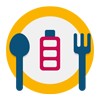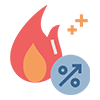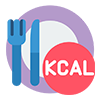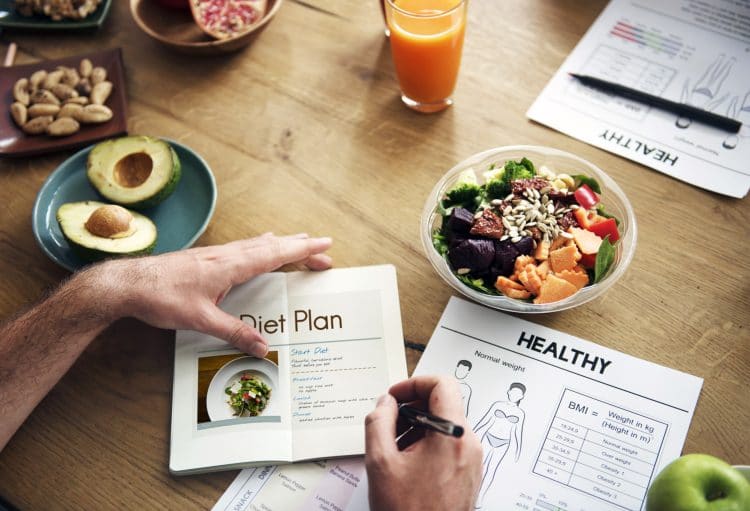This calculator will give you the science backed estimate of your recommended daily calorie intake for weight loss.
How Many Calories Should You Eat in a Day?
How To Use This Calorie Calculator
This calculator is very simple, and straightforward.
To ensure an easy experience for you, we’ve included step-by-step instructions in detail below.
Step 1: Choose your preferred unit of measurement: Imperial (lbs, hours, and minutes) or metric (kilograms, hours, and minutes).
Step 2: Select your gender.
Step 3: Enter your weight.
Level Up Your Fitness: Join our 💪 strong community in Fitness Volt Newsletter. Get daily inspiration, expert-backed workouts, nutrition tips, the latest in strength sports, and the support you need to reach your goals. Subscribe for free!
Step 4: Enter your height.
Step 5: Type in your age.
Step 5: Provide your body fat percentage (Optional). Doing so may provide a more accurate estimate.
Step 6: Choose your weekly activity habits.
The options include:
- No exercise (Desk job)
- Light exercise (1-3 days/per week)
- Moderate exercise (3-5 days/week)
- Hard exercise (7 days/week)
- Extremely active (Twice or more/day)
Step 7: Hit Calculate
Here’s an example to ensure you understand how to interpret your results and use this information to help you drop those lbs.
Let’s use the example of a 30-year-old, 6 feet tall, 175-pound male who is moderately active.
This individual needs 2779 calories to maintain his current body weight of 175 pounds. To lose one pound, he will have to create a 500-calorie deficit from his maintenance calories (2379 calories per day). To lose two pounds, subtract 1000 calories from the maintenance calorie (1979 calories per day).
There’s nothing complex about using this calculator. It’s very easy to use and straightforward.
You can also learn the best strategies for splitting up your calories per meal using this calculator.
How Many Calories Should I Eat Per Meal?
Lets break down your daily calories to 4 meals like this:
- Breakfast: 15% – 20%
- Lunch : 30% – 40%
- Dinner : 30% – 40%
- Snacks : 10% – 15%
Meal Calories Calculator
Breakfast: 15% – 20%
What should you eat for breakfast?
Choose a combination of foods to maximize your nutrient consumption.
Avoid:
- High sugar processed cereal
- High sugar fruit, most fruit apart from berries.
Aim for:
- High natural fats foods like: eggs, yogurt, cheese and avocado
- Healthy slow releasing carbohydrates such as whole meal bread
- Antioxidant and low in sugar like berries
Lunch : 30% – 40%
Aim for 25% – 30% protein in your lunch.
Healthy sources of protein include:
- Fish
- Eggs
- Meat
- Nuts
- Lentils
25% – 30% complex slow releasing carbohydrates such as:
- Whole meal bread
- Brown rice
- Sweet potatoes
Rest 40-50% go for fresh vegetables.
Avoid:
- High calorie foods and toppings.
Dinner : 30% – 40%
Just like your lunch you can divide your dinner plate to:
- 25% protein
- 25% starches
- 50% vegetables
Snacks : 10% – 15%
Eat healthy snacks such as:
- Low calorie yogurt
- Handful of nuts or seeds
- Small portion of fresh fruit
Use our ADVANCE meal calorie calculator to customize the proportions and number of meals per day.
How Does This Calculator Estimate How Many Calories I Should Eat If I Want To Lose Weight?
To understand the functionality of the calculator, it’s important to understand how the weight/fat loss process works.
To lose body fat, you have to create a negative energy balance. That means burning more calories than you consume. This can be achieved through either exercise, eating fewer calories, or a combination of both (recommended).
HIIT vs. LISS Cardio: Which One Is Best for Fitness and Fat Loss?
But not so fast… many will simply take in little to no calories in an effort to slim up. Sure, anyone can lose weight this way. However, it’s not only unhealthy but it’s also unsustainable.
That’s why we create these guides and offer our calculators – to help you achieve your goals and feel good in the process and afterward too.
For most, losing 1-2 “fat” pounds (water and poop don’t count) per week is the sweet spot. This will help to preserve muscle tissue, prevent weight regain, keep your body and skin looking healthier and hormones in check, and it’s just more sustainable.
Although, in certain, more urgent instances, a faster lose weight rate may be necessary.
So how do you drop weight safely and effectively?
Well, first you’ve got to determine your maintenance calories or total daily calorie expenditure (TDEE).
The calculator determines someone’s TDEE based on their gender, age, weight, body fat (optional), and activity habits.
From there, you’ll be recommended a calorie deficit for weight loss.
The calculator uses a formula to approximate resting energy expenditure and then it factors in activity intensity and frequency to guesstimate calories burned.
Weight loss calories recommendations
So it’s important to note that the calculator may be most accurate for those who are just starting out on their weight loss journey or those who’ve made some progress but are still far out from reaching their goal/s.
Why’s that?
The calculator uses the 3500-calorie (.45kg) rule or that one pound of body fat contains 3500 kcals.
This means if you want to lose one pound, you’ll have to burn 3500 calories. That’s 500 calories per day.
So if your maintenance calories are 2500, you’ll need to consume 2000 calories per day to lose a pound per week. If you plan to lose two pounds per week, then deduct 500 more calories or 1000 calories total for a daily intake of 1500 calories.
Why 3500 calories isn’t always the right method
Factors like your body fat, muscle tissue, metabolism, and the thermic effect of food can all influence the number of calories you need to burn to lose and even gain a pound of body weight. Calorie needs change as we change.
If you’d like a more specific tool for weight loss goals and have already made decent progress, the weight loss target date calculator offers a little more flexibility.
Related: The Top 20 Simple Weight Loss Tips
Why The Calculator Won’t Recommend Fewer Than 1000 Calories Per Day
Consuming fewer than 1000 calories per day is not the healthiest way to go about dieting. However, it can and does work for some people but is only recommended with medical supervision.
For example, a very low-calorie diet (800 calories or less) is used for dangerously overweight individuals (no more than 12 weeks), before surgeries, or for fertility treatment (1).
But for most, this is too few calories and also what causes rapid weight loss, muscle loss, weight gain, and oftentimes nutritional deficiencies that can lead to unpleasant side effects. This is especially very dangerous for women who are pregnant or breastfeeding.
Manytimes, people follow a low-calorie diet but they eat empty-calorie foods which makes things worse.
Generally, 1200 calories per day is the minimum recommendation for weight loss.
Difference Between Weight Loss and Fat Loss
Although the two terms can be used interchangeably, it’s easy to see how they can have different definitions.
For example, weight loss may mean losing any form of body weight such as fat, water, glycogen, poop, and, although not ideal, muscle tissue.
Typically, fat loss means losing body fat.
Try out our body fat calculator to estimate your body fat percentage.
Whether or not you’ve ever realized that there could be a difference in meaning, it’s more important that your lifestyle reflects your desired goal.
6 Best Thermogenic Pre-Workouts To Boost Fat Loss and Shred Up
For instance, some people only care about the weight going down on the scale. They may not pay as much attention to macros (protein, carbs, and fat). This may be fine as long as they’re getting adequate nutrients.
Then you have those who are more concerned about looking as aesthetic as possible, which means doing resistance training to build or maintain muscle mass. Subsequently, they’ll focus on burning fat to reveal the muscle underneath.
Learn how to Burn fat with strength training
These individuals are usually more dialed in with their nutrition to ensure they get sufficient protein (crucial for building and maintaining muscle mass), and other macros.
Use our macro calculator to find your ideal protein, carbs, and fat intake based on your body goal/s.
Other calorie calculators
Also be sure to try out our other calorie-based calculators below.
- Body Mass Index (BMI) Calculator
- Basal Metabolic Rate (BMR) Calculator
- Calories burned during over 250 activities
Find Your Per Day Calories
How many calories to eat per day calculator is a basic and easy-to-use tool that’s best suited for people just starting out on their weight loss or weight management journey.
Type in your basic details including body fat percentage (optional) for an estimation of your maintenance calories and it will subtract 500 or 1000 calories for weight loss. It’s really that easy to get started.

 Maintain Weight calories
Maintain Weight calories Weight Loss calories
Weight Loss calories Rapid Weight Loss calories
Rapid Weight Loss calories
















